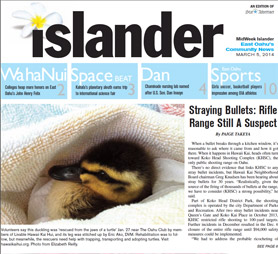Straying Bullets: Rifle Range Still A Suspect
When a bullet breaks through a kitchen window, it’s reasonable to ask where it came from and how it got there. When it happens in Hawaii Kai, heads often turn toward Koko Head Shooting Complex (KHSC), the only public shooting range on Oahu.
There’s no direct evidence that links KHSC to any stray bullet incidents, but Hawaii Kai Neighborhood Board chairman Greg Knudsen has been hearing about stray bullets for 30 years. “Realistically, given the source of the firing of thousands of bullets at the range, we have to consider (KHSC) a strong possibility,” he said.
Part of Koko Head District Park, the shooting complex is operated by the city Department of Parks and Recreation. After two stray bullet incidents near Queen’s Gate and Koko Kai Place in October 2013, KHSC restricted rifle shooting to 100-yard targets. Further incidents in December resulted in the Dec. 6 closure of the entire rifle range until $94,000 safety measures could be implemented.
“We had to address the probable ricocheting of bullets – it’s not really proven, but to be on the safe side, we wanted to just go ahead and do some remediation anyway,” said Todd Hiranaga, District I manager for city parks.
The entire complex was closed between Jan. 13 and 29. Among the changes: a rebuilt backstop which rests behind the 100-yard targets and an “eyebrow” above the shooting line that halts accidental discharges.
City officials and Hawaii Rifle Association members came to the Jan. 28 neighborhood board meeting to assure the community that the facility was once again safe. But Knudsen claims that this wasn’t the case. Curious about KHSC’s progress, he took a walk in late January to a hill between the range and Hanauma Bay. While there, he caught a glimpse of something he thought had been gone for months – metal targets at 440 yards. He claims he was told as far back as Dec. 7, 2013, that these had been removed.
“They are visible to the naked eye – if you know what you’re looking for. … If you’re looking through a rifle scope, and if you know they’re there because that used to be your favorite target … They had to know that those targets were still there.”
Hiranaga stated that metal targets have been removed as of Feb. 24, thanks to a group of weekend volunteers. “The problem with that was they’re lodged in undeveloped places, way back by the mountains …
They removed all the illegal targets, any kind, and these are just metal targets put out there by whoever’s shooting them … I know some people were a little upset because we couldn’t get them right away. But you know, it’s not like you can just walk there … and just take them out.”
But Knudsen, who emailed various city departments documenting safety issues, claims he went out to the range himself on Feb. 21 after closing hours to remove the targets – one day before the city’s crew.
He further believes that other improvements made are still not enough to address safety concerns. A proper eyebrow, he said, means “no blue sky”; a shooter shouldn’t be able to see sky above or in front from where he aims. The one installed doesn’t meet this requirement, he claims, and the berm behind the 100-yard targets should have been raised further.
Hiranaga said remediation is an ongoing process. “Our first concern was safety, so we wanted to get in there. … They’re still monitoring what we did. … I don’t know if we satisfied everybody’s concerns, but so far everyone’s reviews we got in the monitoring seems to be OK. So we’ll keep monitoring from here on. We’re not saying, ‘We’re done, that’s it’ – no.” He also affirmed that the city hopes these emergency repairs are the beginning of an improved facility.
But Knudsen is disappointed in the city’s handling of the concerns. “(The city is) well-aware now that we’re wanting more professional-level, national standards kind of safety improvements. It’s been allowed to deteriorate both physically and with regard to safety, and it just needs some major attention. It needs higher priority, and it needs funding.”






